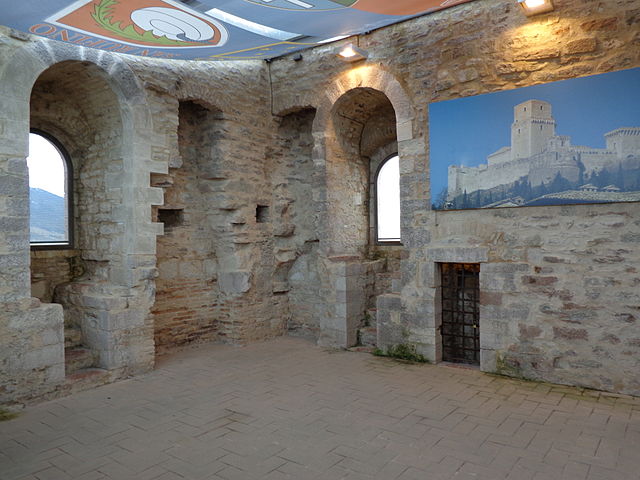Rocca Maggiore
From Wikipedia, the free encyclopedia
From Wikipedia, the free encyclopedia
The Rocca Maggiore is a castle which dominated, for more than eight hundred years, the city of Assisi and the valley of Tescio, constituting their principal defensive fortification.


It ws built in 1316, and omprises two fortresses, Major and Minor.

The first document regarding the fortress dates back to 1173, when the German diplomat and Catholic Archbishop Christian of Mainz (1130 - 1183, chancellor of Germany during the reign of Emperor Frederick I Barbarossa, occupied Assisi on behalf of the sovereign who stayed there for a short time.[1]
The young future King of Sicily and Emperor Frederick II also lived there, entrusted by his mother Costanza d'Altavilla to the Duchess of Urslingen, wife of Duke of Spoleto and comes Assisi Corrado, confidant of the monarch Swabian.[2][3]
Queen Empress Constance returned to Sicily and then return to Assisi with the wife Henry VI: the baptism of Constantine was celebrated in Cathedral of San Rufino and was imposed the auspicious name (of the two grandparents) Frederick Roger.[4]
In 1198, the city passed to the Guelphs of Pope Innocent III, and the people, causing extensive damage to the fortress, drove out the imperial legate and Frederick, who was only four years old. In that year, Francis of Assisi was sixteen.[5]
The fortress was reconstructed in 1356, on the initiative of Cardinal Albornoz (1310 - 1367), who had been commissioned by Innocent VI by Avignon, to strengthen the fortifications of the Papal States.
In 1458, the captain of Perugia and Lord of Assisi Jacopo Piccinino (1423 - 1465 built the polygonal tower north - occidentale, which was then finished by Pope Pius II, and connected to the rest of the walls with a fortified and defensible corridor. The complex consists of fortress walls built with the pink stone of Mount Subasio, trapezoidal, with towers at each corner, which includes square formwork, renovated in 1478 by Sixtus V, on which stands the keep.[6]
The inside of the fortress (where, in 1972, some scenes of the movie "Brother Sun, Sister Moon", directed by Franco Zeffirelli were shot),[7])leads to the entrance of the round bastion, commissioned in 1535 by Paul III. There is a large fenced yard, which contained service rooms, and the mole, former home of the castle, divided into four rooms accessible by a spiral staircase.[8]
The Rocca Maggiore joins, through the fourteenth century walls, with its fortress Minor, or stronghold or keep of St. Anthony, commissioned by Albornoz, in order to consolidate, to the mountain, that part of fortification.[9]
Seamless Wikipedia browsing. On steroids.
Every time you click a link to Wikipedia, Wiktionary or Wikiquote in your browser's search results, it will show the modern Wikiwand interface.
Wikiwand extension is a five stars, simple, with minimum permission required to keep your browsing private, safe and transparent.